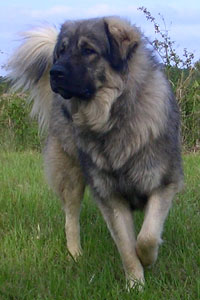Šarplaninac
This article needs additional citations for verification. (March 2014) |
| Šarplaninac | |||||||||||||||||||||||||||||
|---|---|---|---|---|---|---|---|---|---|---|---|---|---|---|---|---|---|---|---|---|---|---|---|---|---|---|---|---|---|
 | |||||||||||||||||||||||||||||
| Origin | Šar Mountains[1][2] | ||||||||||||||||||||||||||||
| |||||||||||||||||||||||||||||
| |||||||||||||||||||||||||||||
| Dog (domestic dog) | |||||||||||||||||||||||||||||
The Šarplaninac (Serbian Cyrillic: Шарпланинац; Macedonian: Шарпланинец, romanized: Sharplaninec; Albanian: Qeni i Sharrit),[3] formerly also known as Illyrian Shepherd Dog (Serbian: Илирски овчар, romanized: Ilirski ovčar; Macedonian: Илирски овчар, romanized: Ilirski ovchar; Albanian: Deltari Ilir), is a dog breed of the livestock guardian type. It is named after the Šar Mountains (Šar Planina), a mountain range in the Balkans. In Ottoman times, the dogs of the breed spent the summer in the area of the Šar Mountains and the winter in Thessaly, depending on the needs of the sheep they are used to protect.[2][4]
Name
The dog breed is named for the Šar Mountains.[2][1] It is alternatively named the Yugoslavian Shepherd Dog by the Fédération Cynologique Internationale (1980), Albanian Mountain Dog, and Šarplaninec[3][2] The breed was initially standardised by the Yugoslav Federation of Cynology (Jugoslovenski kinološki savez, JKS) and recognised as a Yugoslav breed with two types by the Fédération Cynologique Internationale (FCI) in 1939 under the designation Ilirski ovčar ("Illyrian Shepherd Dog"), FCI-Standard N° 41. Kraški ovčar and Šarplaninac were considered Type A and B of the breed. In 1957 the General Assembly of the F.C.I. accepted a motion proposed by the Yugoslav Federation of Cynology to change the name of the breed to Jugoslovenski ovčarski pas Šarplaninac ("Yugoslavian Shepherd Dog Sharplanina"), and this is the official name of the breed. In 1968, type B was recognised as a separate breed under the designation Kraški ovčar ("Karst Shepherd Dog"),[5][6] The breed was formerly known as Ilirski Ovčar (Cyrillic: Илирски овчар, "Illyrian Shepherd Dog") before it was renamed in 1957.[3]
Origin
This breed and its origin are associated with the Šar Mountains region, which is how it got its name.[1] After the collapse of Yugoslavia, Macedonia and Serbia were recognised by the Fédération Cynologique Internationale as the countries of origin.[3]
Characteristics
The Šarplaninac is a large, strongly built dog. The body is slightly longer than the height at the withers, and the front legs account for approximately 55% of the height. The head is large but proportional to the body, with dark eyes.
The Šarplaninac is a robust, well proportioned dog with plenty of bone, of a size that is well above the average and with a thick, long, rather coarse coat that emphasizes the short coupled appearance. According to the FCI breed standard males should weigh between 35 and 45 kilograms (77 and 99 lb) with females slightly smaller at around 30–40 kilograms (66–88 lb).[3] The average height is quoted as 62 centimetres (24 in) for males with females at 58 centimetres (23 in).[3]
The coat is dense, about 4 inches (10 cm) in length, and can be rough or smooth.
All Šarplaninac are solid in colour: fawn, iron grey, white or almost black; usually sable or gray with darker "overalls" on the head and back, the undercoat being paler. The colour need not be completely uniform, and most Šarplaninac have several different shades of the same colour fading into one another. There are no bicolours and no uniformly black-coated dogs among purebreds, but odd-coloured specimens do exist. The dogs must not have large white patches in their coat.
Working life

Dogs of the breed spend the summer in the area of the Šar Mountains and the winter in Thessaly, Greece, depending on the needs of the sheep they are used to protect.[2]
Ban
Šarplaninac is on the list of banned dog breeds in Denmark.[7] The Danish list includes 13 breeds and it is considered controversial having received criticism from dog owners and several political parties because eight of the 13 breeds have no reports of any incident. Among the eight is Šarplaninac.[8]
See also
References
- ^ a b c Yann Arthus-Bertrand; André Pittion-Rossillon (2000). Dogs. Barnes & Noble Books.
- ^ a b c d e Raymond Coppinger; Lorna Coppinger (2002). Dogs: A New Understanding of Canine Origin, Behavior and Evolution. University of Chicago Press. pp. 124–128.
- ^ a b c d e f Fédération Cynologique Internationale: Official FCI-Standard N° 41, Published 24 November 1970. – Retrieved on 14 February 2015.
- ^ Hristov P. (2015) The Balkan Gurbet: Traditional Patterns and New Trends, p. 36. In: Vermeulen H., Baldwin-Edwards M., Boeschoten R. (eds) Migration in the Southern Balkans. Springer, 2015; ISBN 3319137190, pp. 31-46.
- ^ FCI-Standard N° 278. Archived 25 October 2017 at the Wayback Machine
- ^ United Kennel Club: Official U.K.C. Breed Standard, Revised 1 July 2009. – Retrieved on 30 March 2010. Archived 2 March 2016 at the Wayback Machine
- ^ "Danish Legislation on Dogs". Ministry of Environment and Food of Denmark. 13 March 2019. Archived from the original on 5 July 2013. Retrieved 12 February 2019.
- ^ Government won’t change criticised list of illegal dog breedsat cphpost.dk, 21-10-2013, retrieved 14-9-2019 Archived 23 November 2017 at the Wayback Machine
- Webarchive template wayback links
- Articles needing additional references from March 2014
- All articles needing additional references
- Use dmy dates from January 2020
- Articles with short description
- Short description with empty Wikidata description
- Articles with 'species' microformats
- Articles containing Serbian-language text
- Articles containing Macedonian-language text
- Instances of Lang-mk using second unnamed parameter
- Articles containing Albanian-language text
- Instances of Lang-sr using second unnamed parameter
- Articles with missing files
- Commons link is defined as the pagename
- FCI breeds
- Dog breeds originating in North Macedonia
- Dog breeds originating in Serbia
- Livestock guardian dogs

